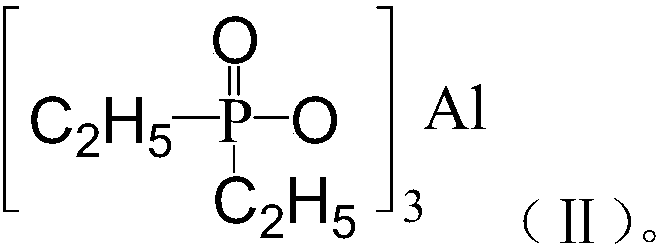Halogen-free flame-retardant compounding system coordinated with organic aluminum phosphite and application of same to glass fiber reinforced engineering plastics
A technology of organic aluminum phosphite and engineering plastics, which is applied in the field of halogen-free flame retardants, and can solve problems such as loss, generation of toxic gas, and easy precipitation
- Summary
- Abstract
- Description
- Claims
- Application Information
AI Technical Summary
Problems solved by technology
Method used
Image
Examples
Embodiment 1
[0060] The halogen-free flame retardant composite flame retardant system is applied to glass fiber reinforced nylon, and the performance of the flame retardant is investigated according to the following steps and test methods.
[0061] (1) Mixing of halogen-free flame retardant system
[0062] Add the components of the compound flame retardant system and other additives that have been weighed in advance according to the ratio into the high-speed mixer, start high-speed stirring, and stir for 10 minutes to complete the mixing of the halogen-free flame retardant system powder and discharge.
[0063] (2) Extrusion granulation of materials
[0064] Set the temperature of each zone of the twin-screw extruder at the predetermined temperature. After the temperature is stable for 20 minutes, add the nylon system from the hopper, add the glass fiber through the glass fiber inlet, and feed the halogen-free flame retardant system powder through the powder feeding hole, start The host an...
Embodiment 2
[0084] The implementation process is the same as in Example 1, except that the ratio of aluminum diethylphosphite is maintained, and the ratio of aluminum methyl phosphite, melamine aluminum phosphite and zinc stannate is adjusted, and the total amount of the flame retardant system is kept unchanged. Other materials and proportioning are shown in Table 2, and the obtained material results are shown in Table 2.
Embodiment 3
[0086] The implementation process is the same as in Example 1, except that the ratio of aluminum diethyl hypophosphite and aluminum methyl phosphite is adjusted, and the total amount of the flame retardant system remains unchanged. Other materials and proportioning are shown in Table 2, and the obtained material results are shown in Table 2.
PUM
 Login to View More
Login to View More Abstract
Description
Claims
Application Information
 Login to View More
Login to View More - R&D
- Intellectual Property
- Life Sciences
- Materials
- Tech Scout
- Unparalleled Data Quality
- Higher Quality Content
- 60% Fewer Hallucinations
Browse by: Latest US Patents, China's latest patents, Technical Efficacy Thesaurus, Application Domain, Technology Topic, Popular Technical Reports.
© 2025 PatSnap. All rights reserved.Legal|Privacy policy|Modern Slavery Act Transparency Statement|Sitemap|About US| Contact US: help@patsnap.com



